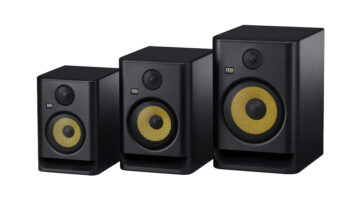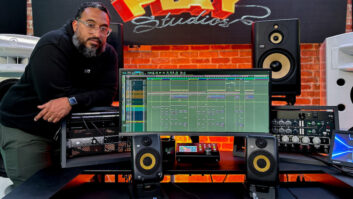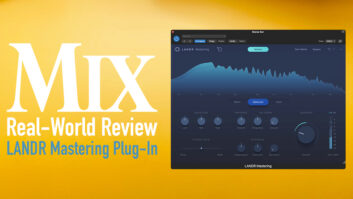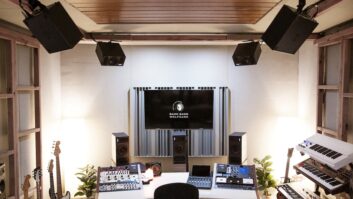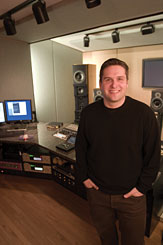

Talking about listening — and the listening process — is one of those seemingly impossible tasks, like writing a book on how to compose music or paint a masterpiece. We can perform the most detailed examination of the auditory process — from ear canal geometry and structure of the tympanic membrane and ossicles to the sensory hair cells within the cochlea and on to the brain — but it won’t tell us why we listen the way we do.
Every aspect of music production is subjective to some degree, so we put aside the clinical, purely scientific approach and spoke to a number of mastering engineers hoping to shed some light on the art and mechanics of critical listening. Putting hearing concepts into words isn’t easy, but their responses proved illuminating, offering insights into the listening process from the vantage point of those who work with the creations of others.
Adam Ayan, a resident of Gateway Mastering
Photo: Brian Lee
THE EMOTIONAL LINK
One of the top practitioners in the field, with 42 years of experience — including 15 years at A&M Records — Bernie Grundman operates Hollywood-based Bernie Grundman Mastering and has a discography that reads like a compendium of modern pop music. Assuming your ears are healthy — possibly a dangerous assumption these days — the ability to listen critically is largely a craft that can be cultivated, says Grundman. “Listening is like anything else: You have to develop yourself,” he says. “If you go to a lot of art museums, pretty soon the really great works stand out. It’s the same with recording or performance: If you’re an engineer, you’ll remember the great ones. You carry that with you, and, until you hear something better, it becomes your benchmark. Listening skills can be learned, but some people have more talent than others.”
In the realm of mastering, much of this skill involves reconciling one’s ability to listen critically while applying technical and aesthetic expertise to a creative work. “We can sit there and twist knobs on a piece of music, but how do you really know when you’ve actually made it a better recording or a more effective recording that communicates better?” says Grundman about the process. “You have to be emotionally open to this music, and once you’re on the emotional wavelength with that piece of music you’ll know whether that knob you turned made it better or worse.”
TAKING A STEP BACK
One of the most critical steps in any mastering project is the first pass, essentially the engineer’s introduction to the project. “On the first pass, I’m first listening for obvious issues, major mix issues — distortion or something like that,” says Paul Elliott, a 16-year veteran who’s the chief mastering engineer for Disc Makers’ SoundLab, a three-room mastering facility at the company’s headquarters in Pennsauken, N.J. “It’s kind of like the 30,000-foot view, where you determine whether there’s anything that I’ll need to talk to the engineer or artist about. After that, I’m looking at the overall tonal character. Something ‘soft’ in the top end or ‘big’ in the bass may lead to a discussion about how much of this you want to keep.”
STAYING LEVEL

Bernie Grundman knows a bit about mastering after 42 years of working in the biz.
Photo: David Goggin
Playback levels are another important aspect of the listening process. “When I’m first listening, I’m conservative and listen fairly low — around the mid- to low 80s, which is slightly above conversation level,” says Elliott. “This tends to point out anything that’s a major mix issue with the project, although obviously, with bass, you need to play back a little louder to hear what’s going on there.”
Some mastering engineers set a reference level and stick to that for most of the project, such as Adam Ayan, who has operated a suite in the Gateway complex in Portland, Maine, since 2001. “I operate at a fixed level whenever I’m EQ’ing, and it’s somewhere between 85- and 90dB SPL-A,” says Ayan, a Grammy Award winner with a diverse list of credits, including the Rolling Stones, Nirvana, Faith Hill, Linkin Park, Nine Inch Nails and Sarah McLachlan. “That’s not really loud, but once I have my EQ set I can give my ears a break and turn it down a little more once I’m running passes down or at the point of doing some editing. Occasionally, I might bring it up a hair or bring it down somewhat when I’m EQ’ing, just to hear what it sounds like at different volumes, but I’m pretty much staying consistently in the 85 to 90dB range when EQ’ing.”
Fred Kevorkian agrees about the importance of maintaining consistency in the listening process. Kevorkian operates Kevorkian Mastering within Manhattan’s Avatar Studios. He has a background in live sound, broadcasting and studio recording (including nine years as chief engineer at the legendary Sear Sound), as well as more than a decade of mastering experience for acts such as the White Stripes, Iggy Pop, Dave Matthews Band, Beyoncé, Sonny Rollins and others.
“For the past eight years, I’ve been using the same monitoring system,” Kevorkian says. “I use two sets of speakers: large Dunlavy SC-IVs with a pair of Velodyne subwoofers and customized small powered speakers. I only EQ on the main system and use the tiny ones to check and match the average level ‘energy’ for each song of the project. It’s easy to get fooled by a track that has a lot of low end. My small monitoring system might not be accurate as far as fidelity goes, but it gives me an honest representation of how the track sounds on a cheap consumer system.
“High level monitoring is mostly how I like to EQ the tracks,” Kevorkian continues. “I don’t know exactly what SPL I’m listening at, but it’s always the same and I am very comfortable with it. As long as my ears aren’t buzzing and my clients are happy with the result, I’ll keep the same approach. Listening at a loud level is more like a feel. I know my room well and that’s how I can evaluate the low end and how much presence the track should have. Once I feel comfortable with the EQ, I turn it down, tweak a little more and capture the file. To me, a softer listening level is best when I need to hear details, mix balances, et cetera. It’s important to check your work both ways.”

Fred Kevorkian in his mastering suite within New York City’s Avatar Studios
Photo: Alison Hartwell
PROTECTING THE TOOLS
In any listening situation, ear fatigue represents a serious problem. Fatigue not only affects long-term hearing health, but, by changing the way we hear, it also affects our sonic judgments.
For Ayan, who mostly stays within a moderate playback window, part of the solution is simply being aware of the problem. “The most important thing for me is just to turn the monitor level down when I don’t need to listen critically,” he says. He avoids the pitfalls of fatigue and keeps his ears fresh, thus extending his work time.
Elliott’s situation is similar, yet he also supervises other engineers within the facility. “We take our time doing a project and step away from the room occasionally, taking a break and not hammering ourselves,” he notes. “Each of our rooms has a dB meter, and I make sure our engineers are cognizant of the volumes we’re listening at.”
That may sound simple and sensible, but it’s not always as easy as it sounds. “It’s toughest in client-attended sessions,” Elliott adds. “For some of those people, this is the best listening environment they’ve ever heard and they want it cranked. And as you make improvements, they want it cranked more, so sometimes those sessions are the hardest to deal with.”
Grundman listens around 90 dB, which he feels is a “good, healthy level for listening,” and he doesn’t experience ear fatigue when working in the 80 to 90dB range. “However, I sometimes go into mix sessions that are really loud and get ear fatigue right away when these mixers play things back loud to impress me.”

Paul Elliott works out of Disc Makers’ SoundLab.
And other factors, beyond level, can play into the ear fatigue equation, says Grundman. “Here, we don’t play back loud, but it depends on the size of the room and the kind of room and speakers you have. If the room is too dead or if the system is brittle and harsh-sounding, you’ll get ear fatigue faster. If the room’s too dead, you’ll be turning up the volume more because you’re not getting any return from anywhere — with not much sound bouncing off the walls or ceiling, so you tend to listen louder.”
Like Ayan, Kevorkian keeps levels under control in noncritical situations. “Once I’m done with EQ’ing, I turn it down or switch to the small speakers while I’m loading the processed files into the computer,” he says, but adds that this period also offers an opportunity to “listen again for distortion and ticks, which are surprisingly more noticeable at low levels. Because I alternate, I don’t experience any ear fatigue by the end of the day.”
According to Kevorkian, digital production itself also has an unintended effect on hearing. “That’s why I like working with tape machines,” he says. “With analog, you might be changing reels and the pace is different. You always have that minute or so of silence during rewinding when your ears can recover. It’s not like hitting a DAW button and instantly hearing playback.”
THE REFERENCE POINT
Establishing a reference is an essential part of tweaking a project and adding cohesiveness. “All of my work involves comparing the current song I’m working on against the previous ones,” says Kevorkian. “That’s why it’s key to get the first one right. I don’t necessarily master the songs in the running order. I like to start with the loud ones and compare them to each other as I go on. I keep the ballads and acoustic tracks for last. When it’s time to sequence the album, then everything falls into place nicely.”
The situation is infinitely more complex when an engineer is working on compilations where the masters not only came from different studios and producers, but also from different artists at various points in their career. “These days, it’s common to get projects that have come from a couple different studios, different mix engineers and different producers,” notes Ayan. “Here you have to find some sonic middle ground and make some cohesiveness from track to track so it sounds like an album and not just tracks from different producers. You may have one mix that you can do something different to bring it on one way, but if you bring it in too far compared to the other mixes, they may sound too far apart.”
THE LAST STOP
As what is essentially the last stop before a product is released, the mastering studios and mastering engineers have heard it all in terms of mix flaws. Everyone we spoke to cited the issue of receiving material that was overly pre-compressed, making for problems that are difficult to deal with or just unrecoverable audio. This is a real dilemma, although it’s caused by unfortunate decisions during the mix rather than by differences in listening perception between the mixer and the mastering engineer. There are, however, common issues that stem specifically from such situations and are confronted by mastering engineers every day.
“A lot of times, the vocal can be buried because the vocal’s probably the most foreign element in the recording, and achieving that balance where the vocal should sit is difficult,” warns Grundman. “After hundreds of plays, mixers can get used to the song, think they’re hearing the lyrics louder and end up burying the vocal because they can hear it and they can ‘fill in’ the word in their mind.”
A similar psychoacoustic effect can also happen with surround mixes, Grundman adds. “When I hear them I might think that the vocal is kind of low, but when you hear that same cut with the picture, it’s perfect because when you see the artist singing, your brain fills it in. It works — it’s a really interesting phenomenon.”
These days, everyone wants lots of bass, and the perception of low end has more to do with making the listener believe it’s there rather than packing your tracks with subsonic rumble. “Another thing that’s frequently off in a mix is the bottom end — it’s the hardest thing to get right on any monitor,” Grundman explains. “One problem with bottom is that it tends to be very resonant and rings a lot. It tends to cloud a whole mix. If you can get a sense of level out of the high end of the bass — essentially the higher-end transients — then you don’t need so much bottom. You’ll think it’s louder than it is if you can hear the punchy snap of the kick drum and the slap of the bass.”
LISTENING IS THE KEY
Mastering engineers are valued for their ability to listen, but sometimes the secret to success has little to do with monitors, translatability, levels or even golden ears. As Kevorkian puts it, “Before the first pass, I listen to the clients and find out what they want. To have good ears is one thing, but to listen and find out what the clients want and make them happy is another story. Both of them combine for the best result.”
It’s good advice. Perhaps a little human interaction is the most important part of the critical-listening process.
George Petersen is Mix’s executive editor.

READ:
What other mastering engineers have told Mix about proper mastering techniques


